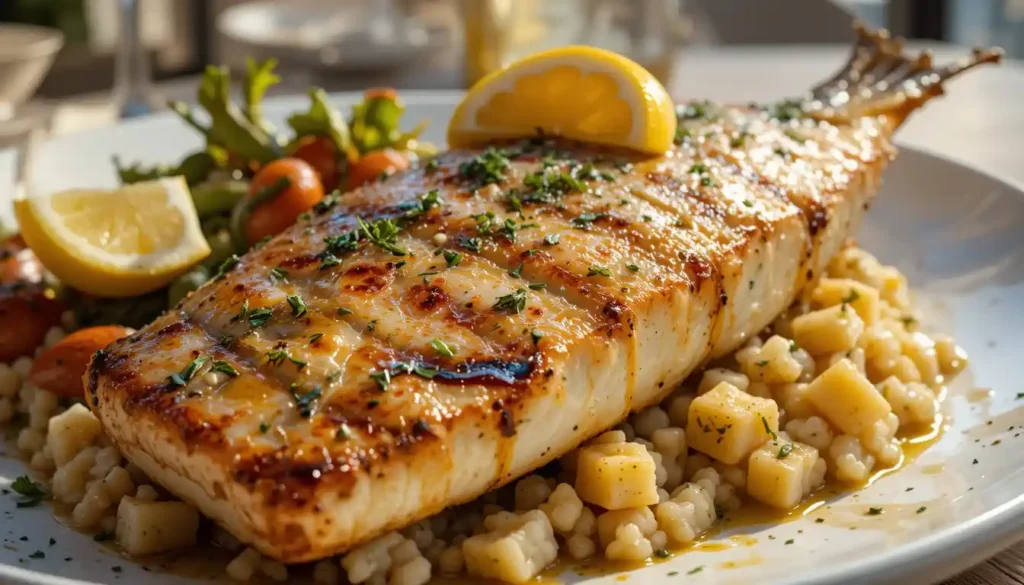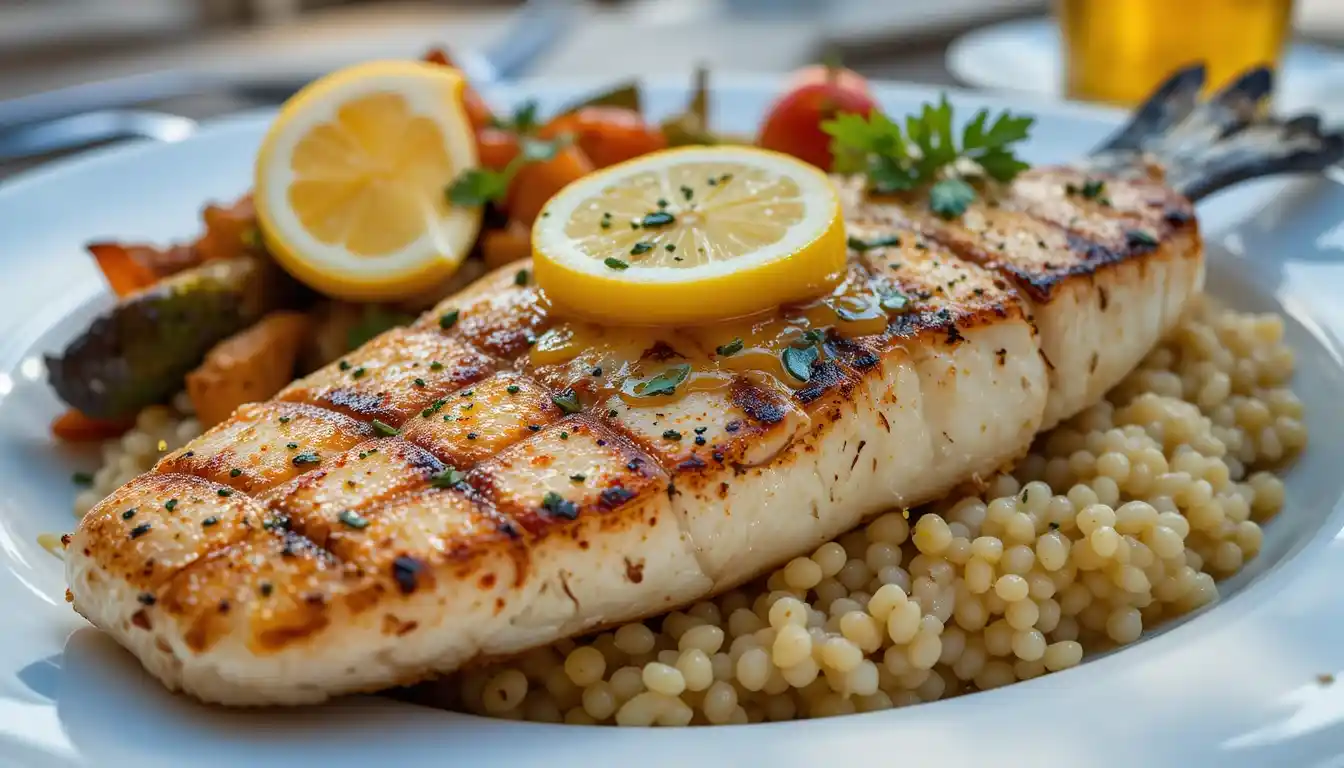Are you looking for a quick and flavorful seafood dish to impress your family or guests? Look no further than a well-cooked swordfish. This meaty fish is not only a delight to the palate but also a nutritious choice, packed with protein and various essential nutrients.
Cooking swordfish can be surprisingly simple, resulting in a dish that’s both tender and full of flavor. With the right recipe, you can achieve a restaurant-quality meal in no time. In this article, we’ll guide you through the process of preparing a delicious swordfish recipe that’s sure to become a favorite.

Why Swordfish Makes an Excellent Weeknight Dinner
If you’re looking for a protein that’s both meaty and mild, swordfish is the way to go. Swordfish has always been a favorite among many due to its thick and meaty texture, making it a great alternative to steak.
Nutritional Benefits of Swordfish
Swordfish is not only delicious, but it’s also packed with nutrients. It’s a good source of protein, vitamins, and minerals, making it a healthy addition to your weeknight dinner routine. As quoted by a renowned chef, “Swordfish is a nutritional powerhouse that deserves to be on every dinner table.”
“Swordfish is a great source of selenium, vitamin D, and omega-3 fatty acids, although in smaller amounts compared to fatty fish.”
Flavor Profile and Texture
The flavor profile of swordfish is distinctive yet mild, often described as slightly sweet with a buttery quality. Its texture is firm and meaty, similar to a tender steak, which makes it satisfying even for those who typically prefer meat over fish. Some key characteristics of swordfish include:
- A clean taste that pairs well with a variety of seasonings and sauces.
- A moist interior with a pleasant flakiness when cooked properly.
- A neutral base flavor that makes it an excellent canvas for bold Mediterranean flavors.
Essential Ingredients for a Perfect Swordfish Recipe
To create a perfect swordfish recipe, you’ll need a few essential ingredients that enhance its natural flavor. The quality of these ingredients can significantly impact the overall taste and texture of your dish.

Selecting Quality Swordfish Steaks
When it comes to swordfish, the quality of the steaks is paramount. Look for steaks that are firm to the touch and have a slightly sweet smell. Fresh swordfish should have a glossy appearance. You can choose between wild-caught and farmed swordfish, depending on your preference and availability.
Key Flavor Components
The right flavor components can elevate your swordfish dish. Olive oil is a crucial ingredient, preferred for its rich flavor, although regular olive oil works well for high-heat cooking. Kosher salt is ideal for seasoning because its larger crystals provide better control. Freshly ground black pepper adds more potency and flavor than pre-ground pepper. For a bit of heat, red pepper flakes complement the other flavors without overpowering the fish.
Pantry Staples You’ll Need
In addition to the key ingredients, having certain pantry staples on hand can enhance your swordfish recipe. These include dried herbs for added depth, quality butter for richness, and a dry white wine for deglazing the pan. These staples can add complexity and a professional touch to your cooking.
Preparing Your Swordfish Before Cooking
Getting your swordfish ready for cooking involves a few simple yet important steps. Proper preparation ensures that your dish turns out flavorful and enjoyable.

Properly Cleaning and Trimming
First, you need to clean and trim your swordfish steaks. Rinse them under cold water, then pat dry with paper towels. If your swordfish has any skin or dark meat, trim it off to enhance the flavor and texture.
Simple Marinade Options
Marinating your swordfish is a great way to add flavor. A classic lemon garlic marinade is a popular choice, made by combining minced garlic, lemon zest, kosher salt, and black pepper, then whisking in olive oil. You can also try other marinades like an Asian-inspired mix with soy sauce and ginger, or an herb-based marinade with fresh thyme and rosemary.
| Marinade Type | Key Ingredients | Marinating Time |
|---|---|---|
| Lemon Garlic | Garlic, Lemon Zest, Olive Oil | 15 minutes |
| Asian-Inspired | Soy Sauce, Ginger, Sesame Oil | 15-30 minutes |
| Herb-Based | Thyme, Rosemary, Parsley, Olive Oil | 15-30 minutes |
Remember to reserve some of your marinade before adding it to the raw fish to use as a finishing sauce after cooking. This will enhance the flavor of your swordfish.
Lemon Garlic Swordfish Recipe: Step-by-Step Instructions
Get ready to elevate your seafood game with this simple Lemon Garlic Swordfish recipe, complete with step-by-step instructions. This dish is perfect for a quick weeknight dinner that’s both flavorful and healthy.
Creating the Lemon Garlic Mixture
To start, you’ll need to create the lemon garlic mixture that will be the flavor backbone of your dish. This involves combining fresh lemon juice, minced garlic, and a selection of herbs. The mixture should be smooth and aromatic, providing a bright contrast to the richness of the swordfish. You can adjust the amount of garlic to your taste, ensuring it’s not too overpowering.
Pan-Searing Technique
Begin by heating a skillet over medium-high heat. Add a small amount of oil to the pan, then carefully place your swordfish steaks in the skillet. Sear the swordfish for about 2-3 minutes on each side, or until it develops a nice crust. This step is crucial for locking in the flavors.
Finishing in the Oven
Transfer the pan with seared swordfish directly to the preheated400°F ovento finish cooking evenly. Theovenphase typically takes only5-6 minutesfor 1-inch thick steaks, but may vary based on the exact thickness of yourfish. Watch for visual cues of doneness: thefishshould be opaque throughout with a slight translucence at the very center. While thefishfinishes in theoven, warm your prepared lemon-garlic mixture in a small pan until it’s melted and fragrant. Remove thefishfrom theovenand immediately pour the warm lemon-garlic mixture over thetop, allowing it to melt into thefish.
| Cooking Method | Time | Result |
|---|---|---|
| Pan-Searing | 2-3 minutes per side | Nice crust on the swordfish |
| Oven Finishing | 5-6 minutes | Cooked through, slightly translucent center |
By following these steps, you’ll achieve a perfectly cooked Lemon Garlic Swordfish that’s sure to impress.
Alternative Cooking Methods for Swordfish
Swordfish can be prepared using a range of cooking techniques, each offering a unique twist on this seafood favorite. While pan-searing is popular, grilling and baking are excellent alternatives that can bring out the best in swordfish.
Grilling Swordfish to Perfection
Grilling swordfish adds a smoky flavor and a tender texture. To grill swordfish to perfection, make sure to preheat your grill to medium-high heat and season the fish with your favorite herbs and spices. A simple marinade can enhance the flavor.
Baking with Tomato Olive Relish
Baking swordfish with a vibrant tomato-olive relish is a flavorful and healthy option. To prepare, preheat your oven to 400°F and place the marinated swordfish in a shallow baking dish. While the fish marinates, seed and dice the tomatoes and kalamata olives, then combine them with salt, crushed red pepper flakes, extra virgin olive oil, and lemon juice.
| Cooking Method | Temperature | Cooking Time |
|---|---|---|
| Baking | 400°F | 12-15 minutes |
| Grilling | Medium-High Heat | 4-6 minutes per side |
By incorporating these alternative cooking methods into your repertoire, you can enjoy baked swordfish and grilled swordfish dishes that are both flavorful and nutritious, with the added benefit of olive and tomato flavors from the relish.
Tips for Avoiding Common Swordfish Cooking Mistakes
A delicious swordfish dish starts with avoiding the most common cooking mistakes. Swordfish is known for its meaty texture and mild flavor, making it a versatile ingredient for various recipes. However, its quality can be easily compromised if not cooked correctly.
One of the most significant challenges when cooking swordfish is maintaining its moisture and tenderness. As noted, “The flavor combination is stunning and perfect over swordfish. It’ll taste like you spent way more time on it than you actually did.” This highlights the importance of enhancing the natural flavor of swordfish without overpowering it.
Preventing Dry, Overcooked Fish
To prevent swordfish from becoming dry and overcooked, it’s essential to monitor the cooking time closely. Using a thermometer can help ensure that the fish is cooked to the perfect internal temperature. Additionally, not over-marinating the swordfish is crucial, as excessive acidity from ingredients like lemon juice can start to ‘cook’ the fish prematurely.
Enhancing Flavor Without Overpowering
When it comes to enhancing the flavor of swordfish, balance is key. A sauce made with citrus elements like lemon or fresh herbs can brighten the dish without overwhelming the natural taste of the swordfish. It’s also important to consider the cooking method; for instance, grilled swordfish can handle bolder flavors compared to delicately baked preparations.
By being mindful of these considerations, you can create a harmonious balance of flavors that complements the swordfish. This approach ensures that the final dish is not only delicious but also showcases the swordfish as the main ingredient.
Delicious Side Dishes to Serve with Your Swordfish
The key to a well-rounded meal is pairing your swordfish with the perfect accompaniments. When choosing side dishes, consider options that complement the flavor profile of your swordfish recipe.
Vegetable Pairings
Vegetables make an excellent side dish for swordfish. Grilled or roasted vegetables like asparagus, bell peppers, or zucchini can add a nice contrast in texture. You can also sauté spinach with garlic or prepare a fresh salad with mixed greens.
Starch and Grain Accompaniments
For starch and grain accompaniments, consider quinoa salad, roasted potatoes, or couscous. These options can complement the flavor of your swordfish without overpowering it, making for a balanced dish.
Wine Pairing Suggestions
When it comes to wine pairing, a crisp Sauvignon Blanc or unoaked Chardonnay pairs well with lemon-garlic swordfish. For tomato-olive preparations, a light-bodied Pinot Noir or rosé is suitable. You can also consider Vermentino or Albariño for bold Mediterranean flavors, or a medium-bodied white with oak influence for grilled swordfish with smoky notes.
Conclusion
This comprehensive guide has provided you with the tools to master the art of cooking swordfish, a true seafood delight. With the baked swordfish recipe as a foundation, you can now experiment with various flavors and techniques to create your own signature dishes. The key principles of proper seasoning, careful cooking, and complementary flavors remain the same whether you’re pan-searing, grilling, or baking your swordfish. By applying these guidelines, you’ll achieve restaurant-quality results in your own kitchen, making swordfish recipe a staple in your culinary repertoire.
FAQ
What is the best way to season swordfish before cooking?
To add flavor to your dish, use a mixture of kosher salt, black pepper, and red pepper flakes. You can also add minced garlic and a squeeze of fresh lemon juice for extra flavor.
How long should I cook swordfish in the oven?
Cooking time will depend on the thickness of your fish and the temperature of your oven. As a general rule, bake at 400°F (200°C) for 8-12 minutes, or until it reaches an internal temperature of 145°F (63°C).
Can I use olive oil for pan-searing swordfish?
Yes, you can use extra virgin olive oil for pan-searing. Heat 2-3 tablespoons of oil in a pan over medium-high heat before adding your fish.
How do I prevent swordfish from becoming dry?
To keep your fish moist, avoid overcooking it. Use a thermometer to check the internal temperature, and remove it from heat as soon as it reaches 145°F (63°C). You can also brush it with a lemon butter sauce during the last few minutes of cooking.
What are some good side dishes to serve with swordfish?
Some popular options include roasted vegetables, quinoa or brown rice, and a simple green salad. You can also serve it with a starch like roasted potatoes or grilled asparagus.
Can I marinate swordfish before cooking?
Yes, marinating can add extra flavor to your dish. Try using a mixture of olive oil, lemon juice, garlic, and herbs like parsley or thyme. Marinate for at least 30 minutes to an hour before cooking.


1 thought on “Swordfish Recipe: Flavorful and Quick Seafood Dish”
Comments are closed.